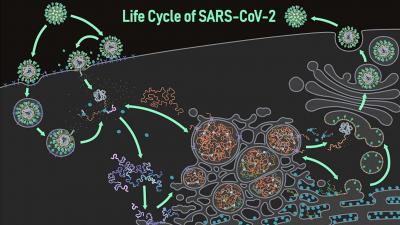Stop spreading
These drugs could potentially stop the spread of the coronavirus. The entry of the virus into the host cell – in which the spike protein plays a central role – is just the starting point of the coronavirus replication cycle.
‘Soon’
“At least 25 other viral proteins contribute to this copying process, and several of these proteins are primary targets for newly developed anti-coronavirus drugs that will soon be available,” says Snijder.
Progress made
In collaboration with researchers from Rockefeller University (New York) and the University of Aix-Marseille, the Molecular Virology group of the LUMC recently published in Nature and in Proceedings of the National Academy of Sciences of the USA (PNAS ) highlights the significant progress made in understanding the structure and function of such proteins.
Coronavirus replication
After the coronavirus genome, i.e. the entire genetic code of an organism, has been delivered into the host cell, a complex biological process starts. As a result, all viral proteins – including those necessary for the replication of the virus genome – are made, ultimately leading to the assembly and release of new virus particles.
Host cell infrastructure ‘hijacked’ by coronavirus
Snijder explains: ‘In the first hours after infection, the virus hijacks the host cell’s infrastructure and this ‘hostile takeover’ reprograms the cell to generate a rapidly increasing number of viral genome copies, which in turn are used to make even more viral proteins. to produce’.
Understanding protein structure and function
At least eight enzymes, a special type of protein that perform biochemical reactions needed to copy the viral genome, must work together to direct production of the coronavirus genome in the infected cell. At the beginning of the COVID-19 pandemic, relatively little was known about their molecular structure and interactions.
‘Copy machine’
‘But thanks to groundbreaking technological advances, for example in electron microscopy, great progress has been made in the last few years. This method has made it possible to visualize the molecular structure of individual enzymes and to study how they together form a ‘copying machine’ that controls the production of new virus genomes’, says Snijder. The researchers from the LUMC and Aix-Marseille have now jointly characterized the structure and function of one of these enzymes in more detail.
Antiviral drugs on the way
This knowledge is crucial to gain a better understanding of some special features of the biology of the coronavirus, but also to facilitate the design of small-molecule drugs that can block the specific function of certain enzymes and thus facilitate virus replication. stop. ‘Such virus inhibitors will be an important additional tool in the fight against the COVID-19 pandemic,’ notes Snijder. For example, in the treatment of human infections in cases where vaccination was not possible or failed.
‘Treatment soon after infection’
“They are expected to significantly reduce the risk of developing serious disease, provided treatment is started shortly after infection so that the effect on virus replication can be maximized.” In addition, they are expected to have broad activity against all SARS-CoV-2 variants, as well as related coronaviruses that could emerge in the future,” says Snijder.
Virus inhibitors supplement vaccination and not ‘instead of’
Snijder also emphasizes that the use of virus inhibitors will complement vaccination, and should not be regarded as a substitute. ‘Some population groups, such as people with a hereditary immune deficiency or people taking drugs that suppress the immune system, may be dependent on these alternatives, but preventing infections through vaccination is always a better approach. Most importantly, antiviral drugs will allow us to control outbreaks while vaccines are being developed against, say, a next emerging coronavirus,” said Snijder.
– .


